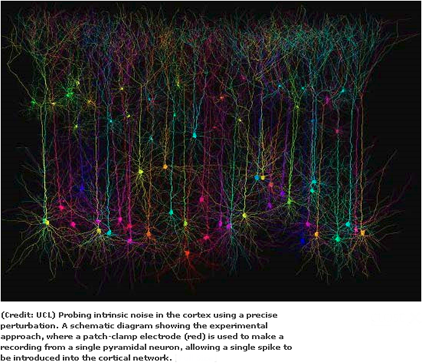Episode 1: Blueprint for the Brain from Science Bytes on Vimeo.
The brain is composed of billions of cells called neurons. One neuron receives inputs from thousands of other neurons and sends out its signals to thousands more. We believe that if we understood the precise pattern with which neurons connect to each other, i.e. which neuron is connected with which other, we would understand how the brain works and how thoughts come about within the brain’s circuitry.
Blueprint for the Brain – 6-minute film by PBS and the Public Library of Science explores how the three-pound lump of jelly inside our skulls enables us to do everything that makes us human, and how scientists are now beginning to decipher the architecture of the brain and its secret lives.
(ᔥ Atlantic ᔥ Maria Popova)
 In the late 1990s, Jane Anderson was working as a landscape architect. That meant she didn’t work much in the winter, and she struggled with seasonal affective disorder in the dreary Minnesota winter months. She decided to try meditation and noticed a change within a month. “My experience was a sense of calmness, of better ability to regulate my emotions,” she says. Her experience inspired a new study which will be published in an upcoming issue of Psychological Science, a journal of the Association for Psychological Science, which finds changes in brain activity after only five weeks of meditation training.
In the late 1990s, Jane Anderson was working as a landscape architect. That meant she didn’t work much in the winter, and she struggled with seasonal affective disorder in the dreary Minnesota winter months. She decided to try meditation and noticed a change within a month. “My experience was a sense of calmness, of better ability to regulate my emotions,” she says. Her experience inspired a new study which will be published in an upcoming issue of Psychological Science, a journal of the Association for Psychological Science, which finds changes in brain activity after only five weeks of meditation training.
Previous studies have found that Buddhist monks, who have spent tens of thousands of hours of meditating, have different patterns of brain activity. But Anderson, who did this research as an undergraduate student together with a team of University of Wisconsin-Stout faculty and students, wanted to know if they could see a change in brain activity after a shorter period.
At the beginning of the study, each participant had an EEG, a measurement of the brain’s electrical activity. They were told: “Relax with your eyes closed, and focus on the flow of your breath at the tip of your nose; if a random thought arises, acknowledge the thought and then simply let it go by gently bringing your attention back to the flow of your breath.”
Then 11 people were invited to take part in meditation training, while the other 10 were told they would be trained later. The 11 were offered two half-hour sessions a week, and encouraged to practice as much as they could between sessions, but there wasn’t any particular requirement for how much they should practice.
After five weeks, the researchers did an EEG on each person again. Each person had done, on average, about seven hours of training and practice. But even with that little meditation practice, their brain activity was different from the 10 people who hadn’t had training yet. People who had done the meditation training showed a greater proportion of activity in the left frontal region of the brain in response to subsequent attempts to meditate. Other research has found that this pattern of brain activity is associated with positive moods. [continue reading…]
 Next time your brain plays tricks on you, you have an excuse: according to new research by UCL scientists published today in the journal Nature, the brain is intrinsically unreliable.
Next time your brain plays tricks on you, you have an excuse: according to new research by UCL scientists published today in the journal Nature, the brain is intrinsically unreliable.
This may not seem surprising to most of us, but it has puzzled neuroscientists for decades. Given that the brain is the most powerful computing device known, how can it perform so well even though the behaviour of its circuits is variable?
A long-standing hypothesis is that the brain’s circuitry actually is reliable – and the apparently high variability is because your brain is engaged in many tasks simultaneously, which affect each other. [continue reading…]

Image:iStockphoto
University of Queensland neuroscientists have, for the first time, been able to demonstrate that moderate exercise significantly increases the number of neural stem cells in the ageing brain.
In research published in Stem Cells, Dr Daniel Blackmore and his colleagues at the Queensland Brain Institute (QBI) have shown that moderate exercise directly increases the number of stem cells in the ageing brain.
Despite the conventional wisdom that we only have a set number of neurons or brain cells, neuroscientists have known for some time that, in healthy brains, the creation of new neurons is an ongoing and lifelong mechanism. [continue reading…]



